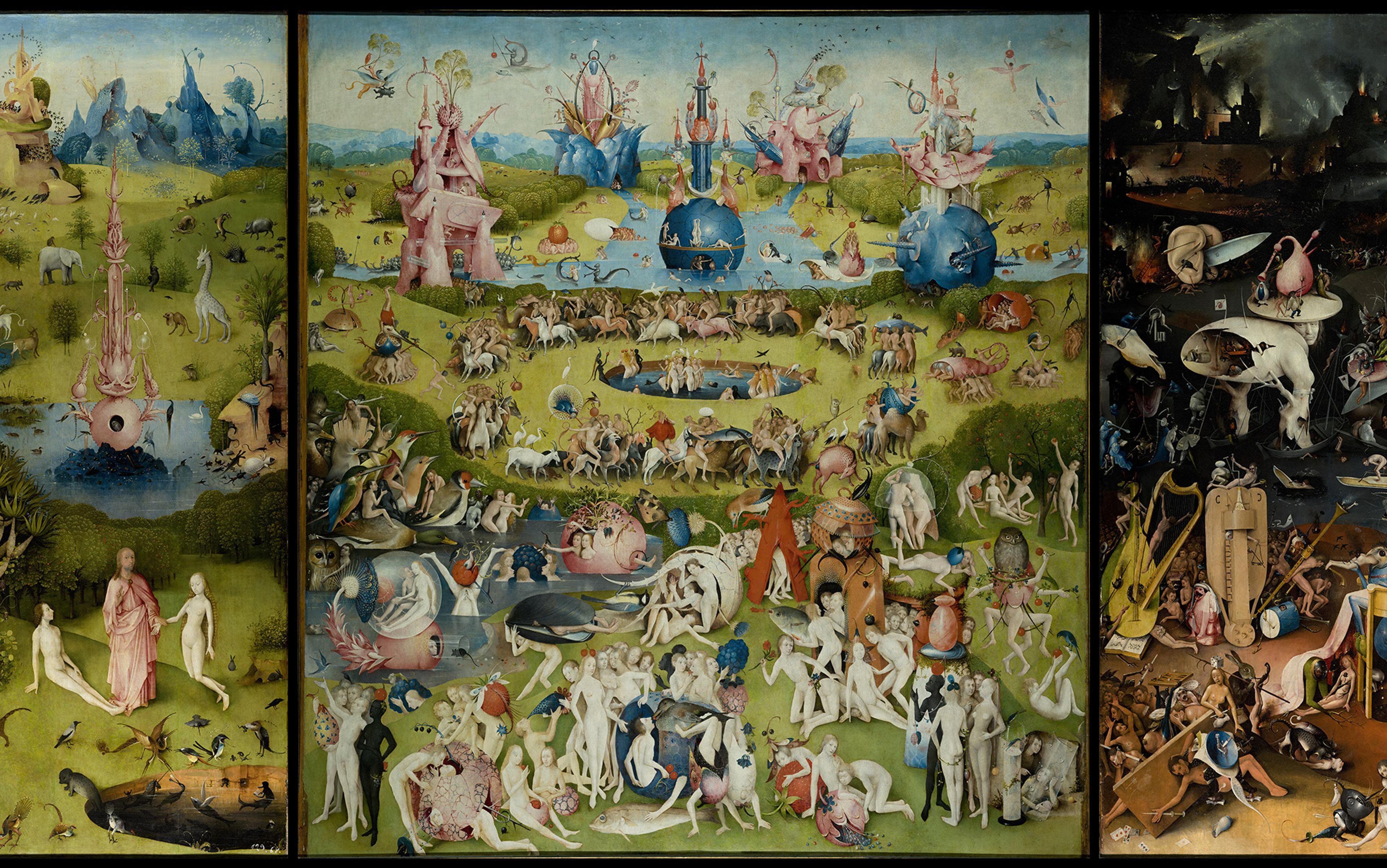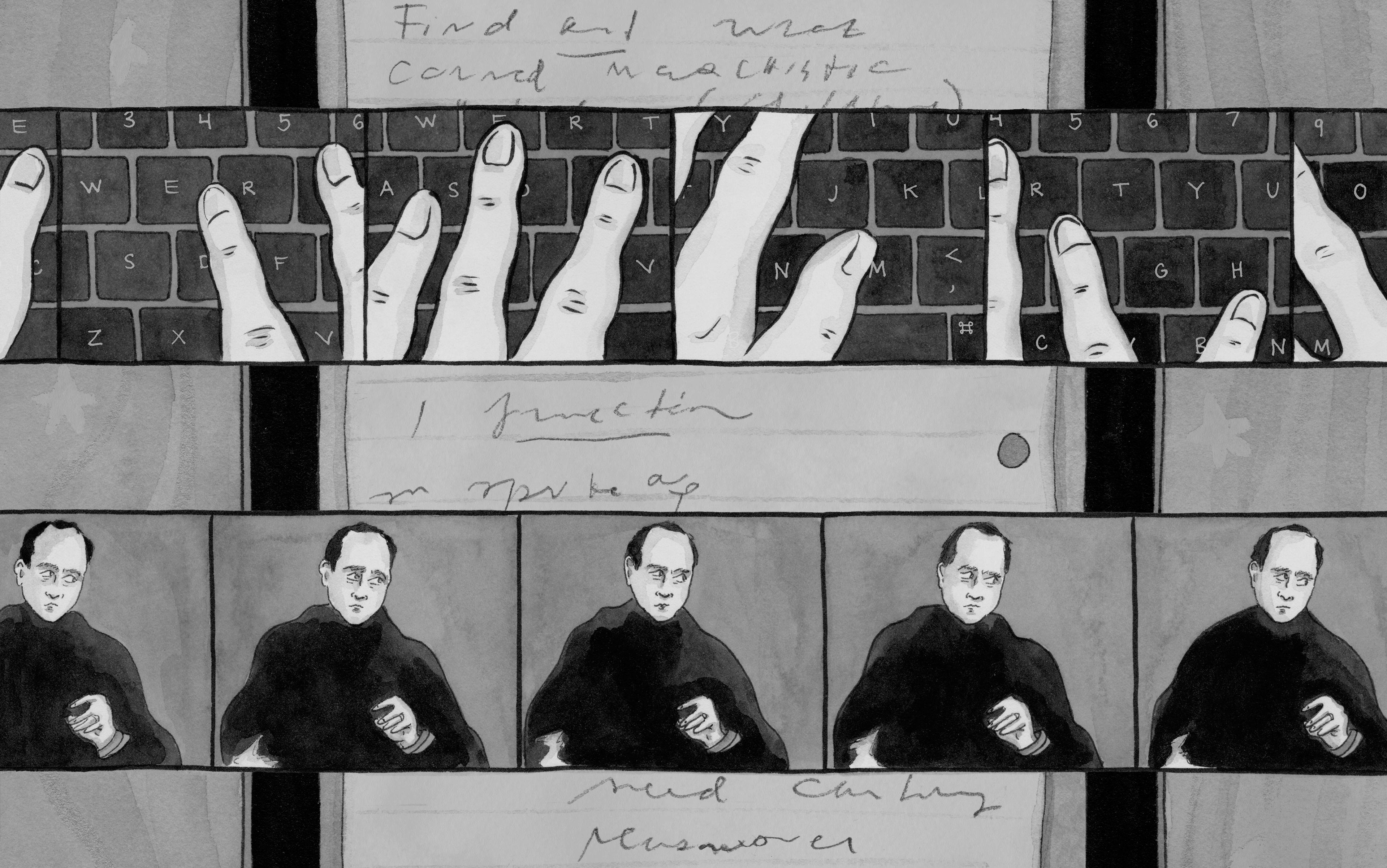I am an accidental birder. While I never used to pay much attention to the birds outside my window, even being a bit afraid of them when I was a child, I have always loved making lists. Ranking operas and opera houses, categorising favourite books and beautiful libraries – not to mention decades of creating ‘Top Ten’ lists of hikes, drives, national parks, hotels, and bottles of wine. My birding hobby grew out of this predilection. Specifically, out of my penchant for writing down the birds I found in the paintings by the Old Masters.
Hieronymus Bosch, for starters.
Bringing my opera glasses to the Museo del Prado in Madrid, I delighted in sitting across the room and counting the birds in Bosch’s painting, today called Garden of Earthly Delights (1490-1510). The triptych, which visualises the fate of humanity in three large panels, is exploding with birds. So far, my list of Bosch birds includes spiralling flocks of starlings amid posing peacocks and pheasants. Closer to the water are storks, egrets and two kinds of herons. A jackdaw and a jay can be identified near a giant ‘strawberry tree’, below which are two spoonbills. And lurking in the trees are three kinds of owls, serving as signs of heresy.
In his book A Dark Premonition: Journeys to Hieronymus Bosch (2016), the Dutch poet and novelist Cees Nooteboom describes seeing Bosch’s work when he was a young man of 21 – and then seeing it again when he was 82. He asks of one picture: How has the painting changed? How has the viewer changed? Am I even the same man now?
These are the questions I ask myself while standing in front of a certain picture by Raphael in the Uffizi. The first time I saw the Madonna del Cardellino (c1505-06) was more than 30 years ago. I was 19. My college boyfriend and I had stopped in Europe on the way back from two magical months in India. It was my first time in Italy. And Florence was so damn pretty.

Madonna del Cardellino or Madonna of the Goldfinch (c1505-06) by Raffaello Sanzio (Raphael). Courtesy the Uffizi gallery, Florence
I vividly recall what a warm day it was, and how overwhelmed I felt by the grand museum. Walking past picture after picture, I turned back to look for my boyfriend, who was trailing behind. And there he was, utterly gobsmacked in front of a painting. So I walked back to look at it too. It was a Madonna by Raphael. A beautiful blonde Madonna, in a rich red dress with her cloak of ultramarine draped over her shoulders, and seated with two babes at her feet. One was holding a goldfinch.
Being young Americans, we couldn’t understand any of it. Why were there two baby boys? If the second was John the Baptist, where was the child’s mother? And were those violets and chamomile under their feet?
In an enchanted world, everything seems to be telling a story
Serious birders sometimes talk about their first bird memory. My own earliest bird-in-a-painting memory was that goldfinch in the painting by Raphael in the Uffizi. Its composition is much like Raphael’s Madonna del Prato (1506), in Vienna – but at the Uffizi, instead of a cross, the children play with a tiny bird. Thirty years later, standing in front of the same painting, I now know the bird symbolises the Christ Child and the Passion.

Madonna del Prato or Madonna in the Meadow (1506) by Raphael. Courtesy the Kunsthistorisches Museum, Vienna
In Catalonia in Spain, there is a wonderful legend that suggests that the jagged and holy mountains of Montserrat rose from the earth at the precise moment that Christ was crucified in Jerusalem – as if the earth itself rose in anger. There was a similar story from the Middle Ages about how the goldfinch received its red spot. Flying down over Christ on the Cross, the bird tried to help Him by picking out a thorn from the Crown – and in this way was forever after splashed with the drop of His blood.
In an enchanted world, everything seems to be telling a story.
Second marriages are notoriously difficult. My new husband had been wiped out financially and emotionally by his previous marriages (yes, there was more than one). By the time I met Chris, he was barely hanging on to the house, his kids showing varying degrees of alienation. It was impressive that he wanted to try again – and so soon? Not six months after our first date and whirlwind romance, we had done it! I sometimes think we were like survivors of a shipwreck; his life was a wreck, but mine was worse. Of course, we underwent couples therapy and laughed off the obligatory (but serious) warnings about our dim hopes of survival. We were just happy to have found each other; happy to be still breathing; for, as Voltaire said in 1761: ‘[E]verything is a shipwreck; save yourself who can! … Let us then cultivate our garden …’
My first marriage had been to a Japanese man. Having spent my adult life in his country, where I spoke, thought, and dreamt in Japanese, I hoped marrying an American would be easier. After all, we shared a language and a culture.
But it wasn’t easier. Marriage is tough in any language.
And so, I have tried much harder this time to cultivate shared values and interests – which is challenging when you are married to an astrophysicist!
‘Hunting birds with a bow and arrow?’ Chris wondered
I do love watching Chris look at art. He becomes intensely attentive, as if every nerve-ending in his body is switched on. It’s not like he’s trying to figure out the nature of galaxy evolution or doing the complicated mathematics that he does when he’s working. He just stands there before the picture, fully present. Most of the time, I have a hard time understanding what he’s thinking about. I know he can build things that go into space. And that he teaches quantum mechanics at Caltech and can perform multivariable calculus. He can even make a cat die and not die at the same time. This is mainly lost on me, which is why I love looking at art together with him. It’s something we can share, something over which we can linger, in each other’s company. That was how my husband and I started going on what we call our ‘art pilgrimages’. From the very beginning of our marriage, we spent enormous amounts of time standing side by side silently looking at Old Masters. Sometimes we might talk a bit, hold hands, and exchange a knowing smile, but mainly we stood there silently soaking it all in.
Shortly after getting married, I took Chris to the Getty Museum, in Los Angeles. I was excited to share my favourite picture in the collection, Vittore Carpaccio’s Hunting on the Lagoon (c1490-95). The museum acquired the painting in 1979, from the collection of the Metropolitan Opera basso Luben Vichey and his wife.
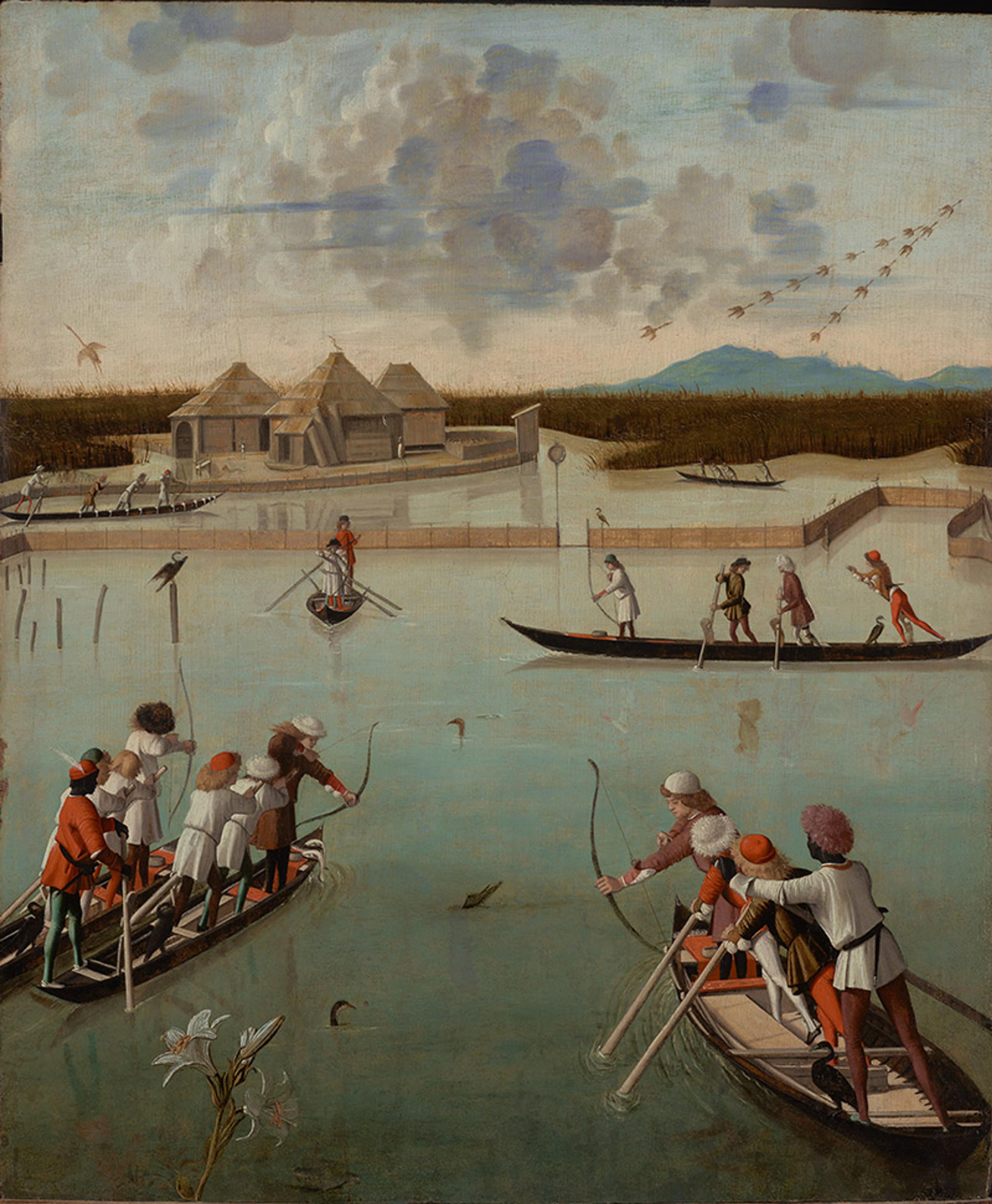
Hunting on the Lagoon (c1490-95) by Vittore Carpaccio. Courtesy the Getty Museum, Los Angeles
Hunting on the Lagoon shimmers with atmospheric effects. Painted in azurite, yellow ochre and lead white, there are touches of costly ultramarine used for the sky and mountains, while vermilion is used on the servant’s jacket. Hunting on the Lagoon depicts a group of aristocratic gentlemen hunting from a small boat on the water.
‘Hunting birds with a bow and arrow?’ Chris wondered.
Looking carefully, you can see they are shooting clay balls at what appear to be grebes.
I tell him that it was apparently the custom to hunt birds in this way so as not to damage their pelts.
‘But what about those dark birds with the serpentine necks sitting one to a boat?’ he asked. I watched his eyes move to the same birds posing on pylons in the water.
‘Unmistakably cormorants.’ And the theory is, I tell him, that the birds were used for hunting fish.
In Japan, you can still see this traditional way of fishing, called ukai. I am always so excited to share something of my life in Japan with Chris, even though it was in the days before we met.
King James was known to have kept a large, and costly, stock of cormorants in London, which he took hunting
I tell him how I watched this kind of fishing years ago. ‘It was at night by lamplight on boats that ply the Kiso River, in Aichi Prefecture.’ The birds, held by what seem to be spruce fibre leashes, were trained to dive for ayu sweetfish and deliver them back to the fishermen on the boats, I say, wishing I could show him.
‘Do you think the custom came to Europe from Japan?’ he wonders.
I think it arrived from China, though that story might be made up. In 17th-century England, King James I was known to have kept a large – and very costly – stock of cormorants in London, which he took hunting. Looking at the painting, however, I thought the practice I’d seen in Japan had been altered almost beyond recognition.
During the Renaissance, the lagoon in the painting must have been jam-packed with fish and mussels and clams and birds. A perfect place to spend an afternoon. But those men, with their colourful hose, with their bows and clay balls, are clearly no fishermen.
It was then that Chris noticed the strange, oversized lilies protruding from the water in the foreground of the painting.
It took him long enough to notice, I thought. Those flowers have driven art historians crazy for generations.
‘Don’t tell me,’ he said, ‘There must be another picture? One with a missing vase, right?’
Right he was!
There is an even better-known painting by Vittore Carpaccio, Two Venetian Ladies (c1490-1510), hanging in the Museo Correr in Venice. We went to see it a few years later. And, sure enough, there is a pretty majolica vase sitting on the wall of the balcony, which seems ready and waiting for those lilies. The two works (painted on wooden panels) fit together, one on top of the other.
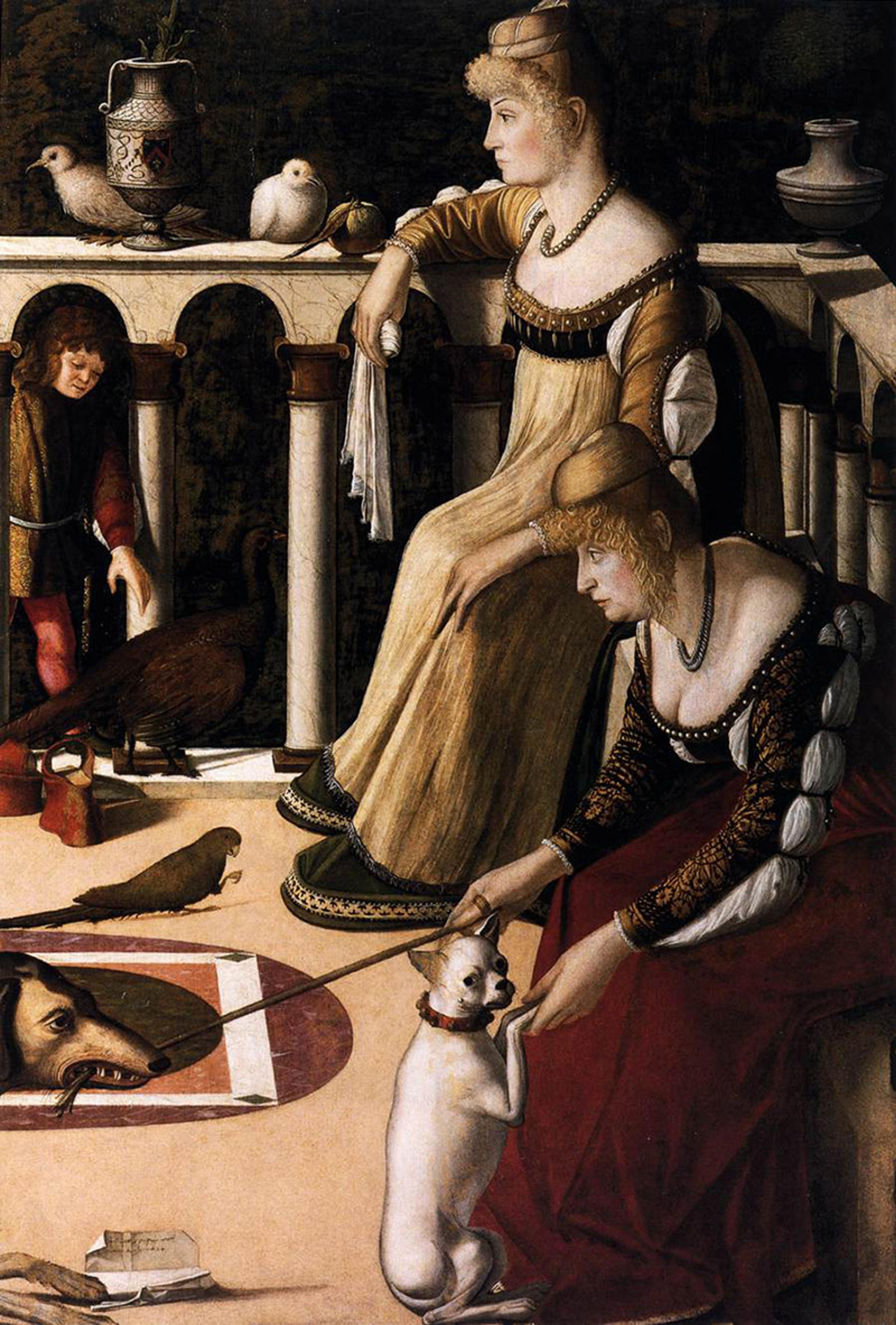
Two Venetian Ladies (c1490-1510) by Vittore Carpaccio. Courtesy the Museo Correr, Venice/Wikipedia
Before this was figured out, art historians believed the two bored-looking ladies to be courtesans. One of the reasons for thinking this was the two doves sitting on the balustrade, which are ancient symbols of Venus and romantic love. But the ladies are also shown sitting next to a large peahen, symbols of marriage and fidelity.
Looking bored, with their tall wooden clogs tossed to the side, they were declared by art historians to be courtesans. Definitely courtesans.

Like pieces of a puzzle, the matched set of paintings has now convinced art historians that these ‘ladies’ are in fact wives of the ‘fishermen’, who are themselves no longer believed to be fishermen but, rather, aristocratic Venetians out hunting waterfowl for sport on the lagoon.
A great painter of dogs, Carpaccio was even better at birds. Beyond his doves, grebes and cormorants, he is perhaps best known for his colourful red parrots. According to Jan Morris writing in 2014, the Victorian art critic John Ruskin was much taken with Carpaccio’s menagerie. At the Ashmolean Museum in Oxford, there is a small watercolour drawing that is a copy of Carpaccio’s red parrot, made by Ruskin in 1875. Calling it a scarlet parrot, Ruskin wondered if it wasn’t an unknown species, and so decided to draw a picture of it in order to ‘immortalise Carpaccio’s name and mine’.
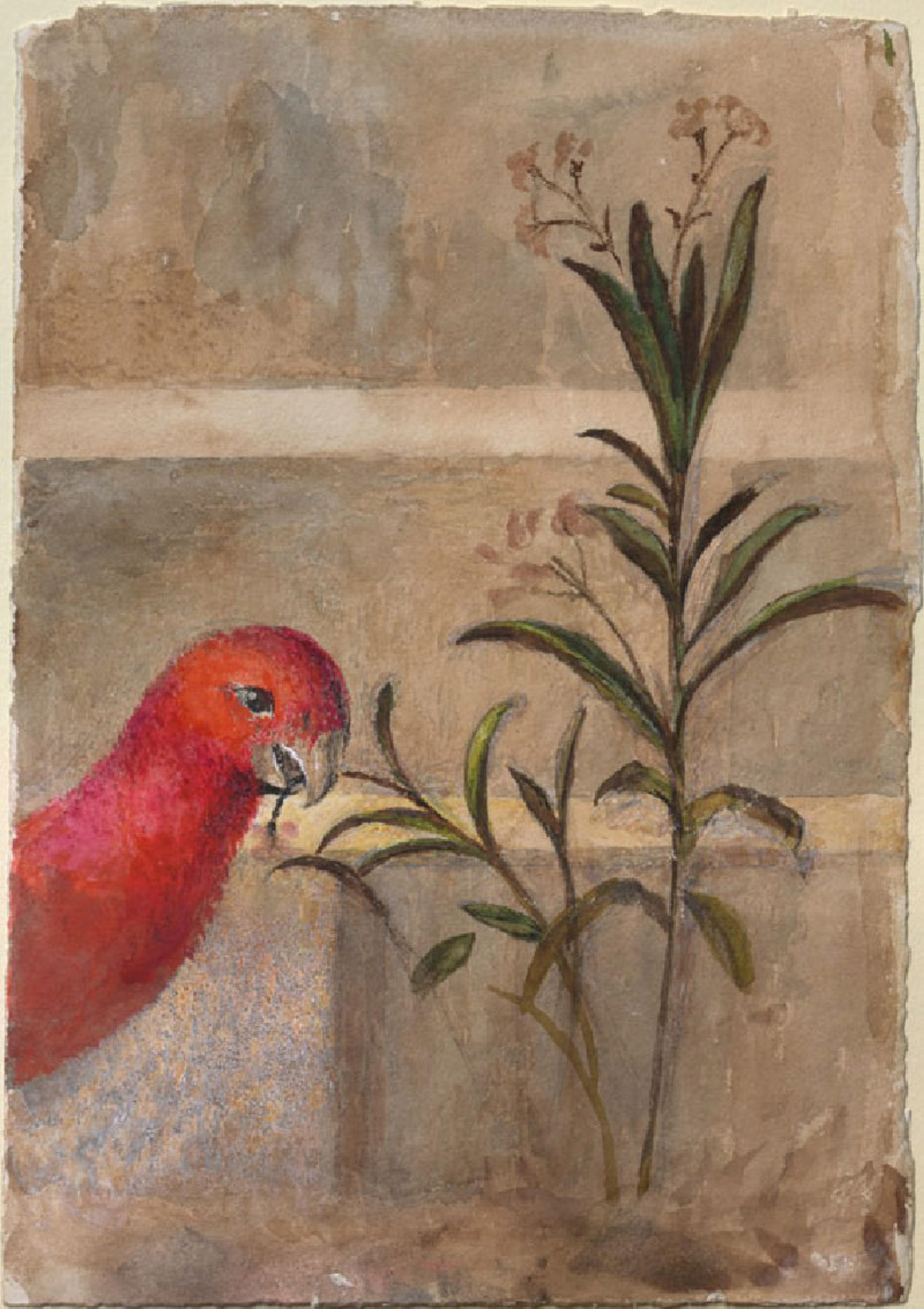
Drawing of a Red Parrot and Plant from Carpaccio’s ‘Saint George Baptises the Selenites’ (19th century) by John Ruskin. Courtesy the Ashmolean Museum, Oxford
It might be classified as Epops carpaccii, he suggested – Carpaccio’s Hoopoe.
Chris and I were delirious to have found each other. Grateful for this chance to have our spirits reborn, we celebrated by taking multiple honeymoons that first year. And without a doubt, the most romantic was the trip we took to Venice – on the hunt to find Carpaccio’s red parrot, which, happily, one can see in the place for which it was originally commissioned: in the Scuola di San Giorgio degli Schiavoni.
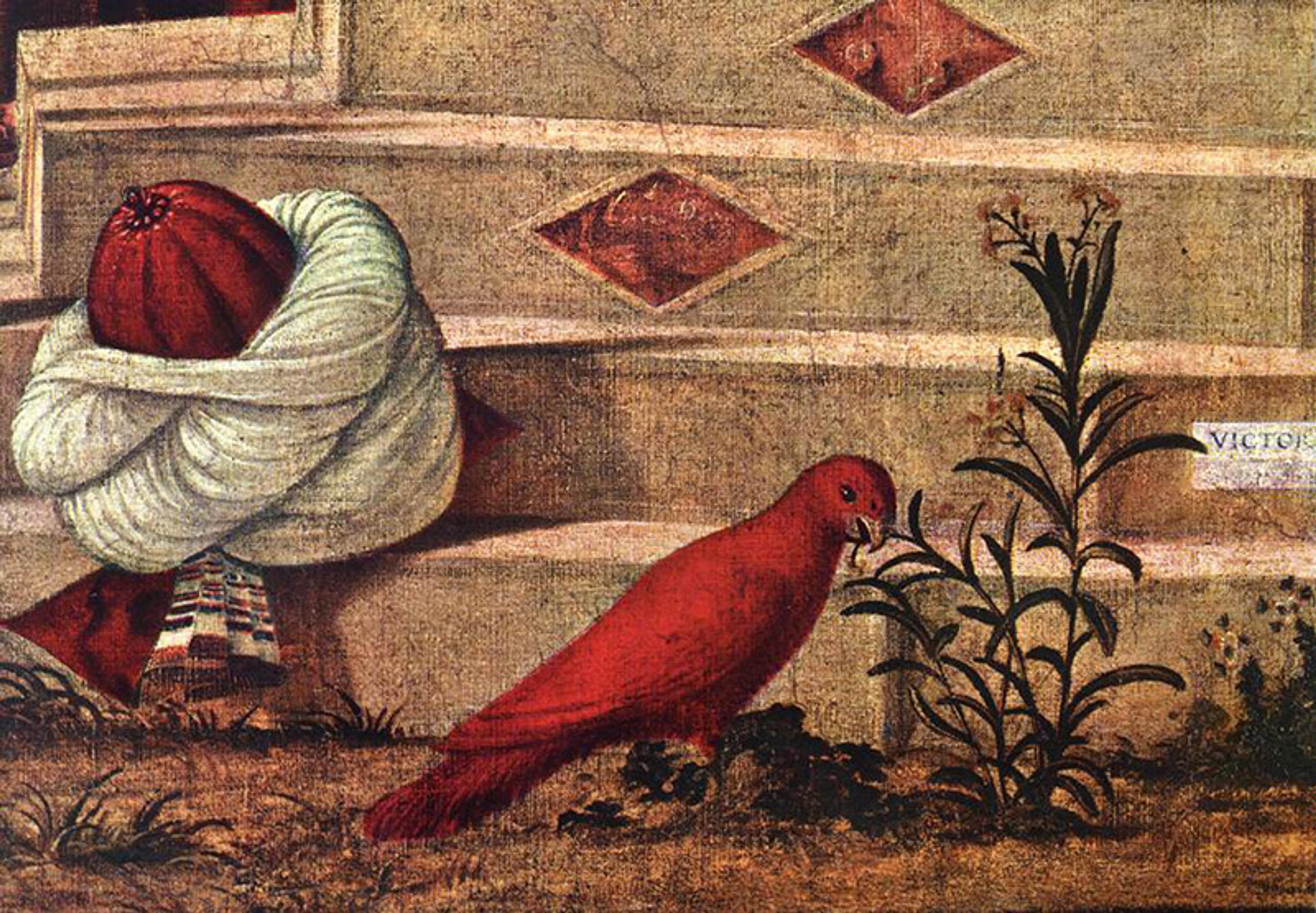
Baptism of the Selenites (detail, 1502) by Vittore Carpaccio. Courtesy Wikipedia
Today, when introducing foreign visitors to Venice’s scuole, tour guides will sometimes compare the medieval confraternities to modern-day business associations that carry out philanthropic activities, like the rotary club. That is probably not far off the mark. Carpaccio’s great narrative cycles were created to adorn the walls of these scuole. The pictures were not merely to decorate, but there to tell stories relevant to the confraternity. Perhaps the best known of these are two of the paintings commissioned by the Scuola di San Giorgio degli Schiavoni.
The red parrot that Ruskin adored is still there in one of the paintings, the Baptism of the Selenites (1502).
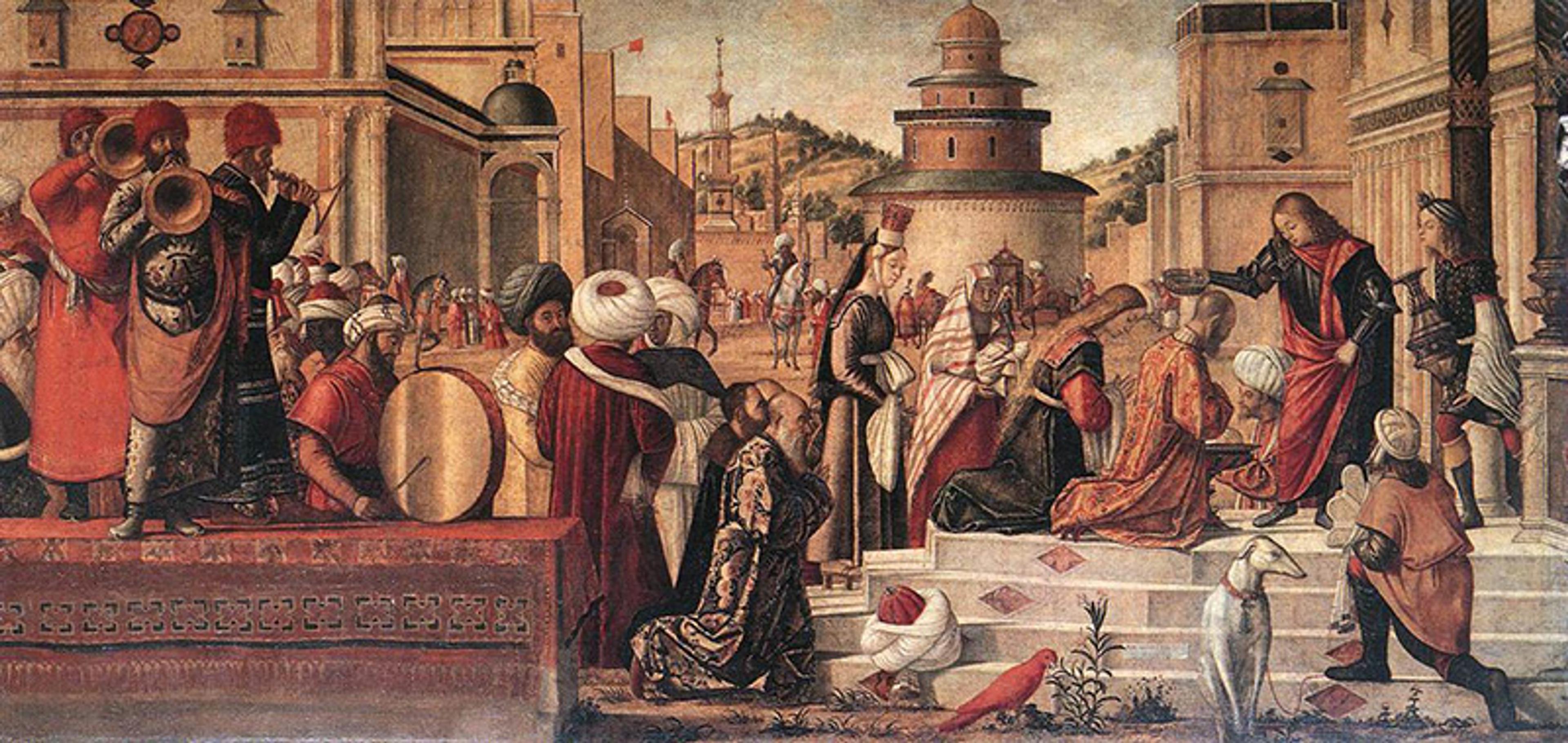
Baptism of the Selenites (1502) by Vittore Carpaccio. Courtesy Wikipedia
Chris and I barely made it in time before the small scuola closed for the day. It was hot and the air heavy in the dark interior. When the author Henry James visited the Schiavoni in 1882, he complained that ‘the pictures are out of sight and ill-lighted, the custodian is rapacious, the visitors are mutually intolerable …’
However, then he magnanimously added: ‘but the shabby little chapel is a palace of art.’
Flannery O’Connor loved her peacocks, calling them the ‘king of the birds’
Eventually locating the parrot, we marvelled at how often such exotic birds can be counted in religious paintings from the Renaissance. We assumed they must be prized like the tulips of Amsterdam during the Dutch Golden Age of paintings, coveted and displayed for their rarity.
I learned only later that it was also because they were a symbol of the Virgin birth. Art historians suggest that this is due to an ancient belief that conception occurred through the ear (and parrots can speak…?) Another more interesting explanation is something found in the Latin writings of Macrobius, who said that when it was announced in Rome that Caesar’s adopted nephew Octavian was triumphant at the Battle of Actium in 31 BCE, at least one parrot congratulated him with: ‘Ave Caesar.’ This was seen as prefiguring the Annunciation and Ave Maria.
In another painting in the scuola, Saint Jerome and the Lion (1509), Carpaccio has drawn what looked to us as an entire bestiary – including a beautiful peacock that seems to be trying to get as far away from the lion as it can.
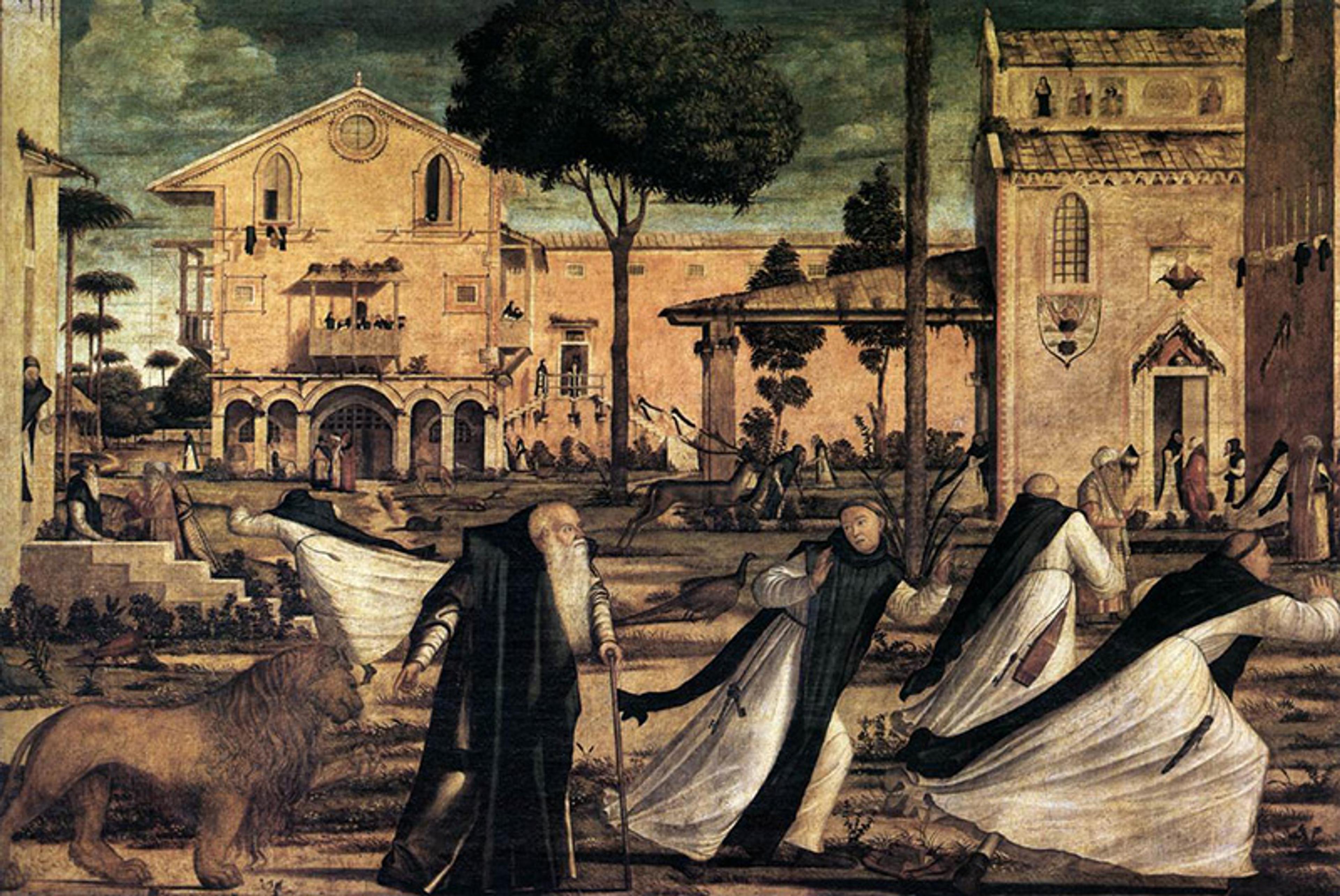
Saint Jerome and the Lion (1509) by Vittore Carpaccio. Courtesy Wikipedia
Peacocks always remind me of Flannery O’Connor, who lived on a farm in Georgia with ‘forty beaks to feed’. She loved her peacocks, calling them the ‘king of the birds’. No matter how her family complained, she remained firm in her devotion. Recently re-reading her essays in the posthumous collection Mystery and Manners (1969), I learned that the Anglo tradition is very different from the Indian one, when it comes to peacocks. In India, they are viewed as symbols of love and beauty, while Europeans typically associate peacocks with vanity and pride. This notion stretches all the way back to Aristotle, who remarked that some animals are jealous and vain, like a peacock.
That is why you find them aplenty in Bosch’s paintings. A warning against the pride of vanity.
O’Connor knew that the peacock was a Christian symbol of resurrection and eternal life. Others concurred. The ancient Romans held that the flesh of the peacock stayed fresh forever. Augustine of Hippo tested this with a live peacock in Carthage, noting that: ‘A year later, it was still the same, except that it was a little more shrivelled, and drier.’ Thus, the peacock came to populate Christian art from mosaics in the Basilica di San Marco to paintings by Fra Angelico in the Renaissance.
Perhaps this is one of the reasons I came to love peacocks so much; as after all, I was experiencing my own kind of resurrection of the spirit with Chris.
The late German art historian Hans Belting wrote about the exotic creatures found in Bosch’s triptych. Belting’s interpretation is interesting, as he views the middle panel – the eponymous Garden of Earthly Delights – as being a version of utopia. By Bosch’s day, the New World had been ‘discovered’ by Europeans – and, indeed, the painting can be dated because of the New World pineapples seen in the central panel. When Christopher Columbus set sail to the Indies, he believed, like many of the theologians of his time, that an earthy paradise existed in the waters antipodal to Jerusalem, just as Dante Alighieri described.
But what is Bosch trying to say?
I don’t think anyone really understands. What we do know is that the triptych was never installed in a church – but was instead shown along with exotic items in the Wunderkammer of his patrons.
Albrecht Dürer, my beloved painter of owls and rhinos, visited Brussels three years after the completion of Bosch’s painting but said not one word about it in his copious journals. Was he disappointed? Scandalised? Belting thinks his silence speaks volumes, and he describes Dürer’s astonishment when visiting the castle and seeing the wild animals and all manner of exotic things from the Americas and beyond.
The lockdowns became a time for me to see the world with new eyes
There was a reason why the Europeans of the time called the Americas the New World, instead of just the ‘new continent’. For this was a revelation, not just of new land, but of sought-after minerals, like gold and silver. It was a new world of tastes. From potatoes to tomatoes and chocolate to corn, the dinner tables of Europe would be transformed in the wake of Columbus’s trip. There were animals never seen in Europe, like the turkey and the American bison.
And hummingbirds.
How wide-eyed those Europeans must have been.
In 1923, Marcel Proust wrote that: ‘The only true voyage of discovery … would be not to visit strange lands but to possess other eyes.’
And this was how I felt coming back to California after two decades in Japan. It was also how I felt during the early days of the COVID-19 pandemic, when time took on a stretched-out quality. To feel oneself slowing down was also to discover new eyes – to begin to savour the seasons changing, the birdsong, or the peaceful sound of the rustling leaves in the palm trees. To listen to the loud rustle of the grapefruit tree just before a huge, round fruit falls smack onto the ground was like a revelation the first time I heard it. And how did I reach 50 years old and never once hear baby birds chirping to be fed – like crickets! The lockdowns became a time for me to see the world with new eyes. And it continues, wave after wave.
It was during that time when our ‘birdwatching in oil paintings’ obsession, mine and Chris’s, was transformed into real-life birding. The pandemic, and lockdown, changed everything.
When restrictions lifted, rather than taking off to museums in Europe, we travelled to Alaska, where we spent weeks traipsing across the tundra in Denali National Park. So often looking down at my feet, I’d marvel at the wondrous tangle of green and yellow lichen; of moss and red berries; and at a variety of dwarf willow and rhododendron, none more than an inch tall. It created a beautiful pattern, like a Persian carpet. Enchanted, I wanted to take off my shoes and feel the spongy earth between my toes.
When was the last time I had walked anywhere barefoot? Even at the beach, I usually keep my shoes on. And not only that, but I had never in my life walked off-trail, much less traipsed across tundra. When I was young, I once camped along the Indus River, in India, but that was so long ago.
How had I become so alienated from wild things?
Life is, after all, constantly shuffling the deck, with each moment precious and unique. All those heightened moments we experienced in our favourite paintings are precisely what the great artists were celebrating. The perfect unfolding of now.
And what was true in the paintings was also true out in the world.
Birding alone and then later in groups, we have savoured those moments when a bird is spotted, and we all grow instantly quiet. Frantically training our binoculars on the object, it seems we are all frozen in a great hush. With laser focus, we attune ourselves to the bird, on a hair’s breadth of losing it, aware of the tiniest flitter, flutter and peep. It is enchantment. And through this, I have felt a little of how birds must have exerted power over the Renaissance imagination too. I continue to marvel at these free creatures of the air, symbolising hope and rebirth, messengers from distant lands, inhabitants of a canvas of beauty and life in this great garden of earthly delights.
The two Carpaccio paintings were reunited last year in an unprecedented exhibition, Vittore Carpaccio: Master Storyteller of Renaissance Venice, at the National Gallery in Washington, DC. It was the first time they were displayed together since 1999, when they were both on show in Venice.
